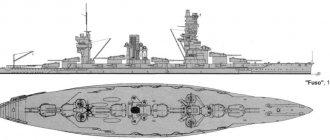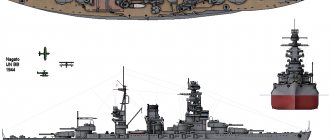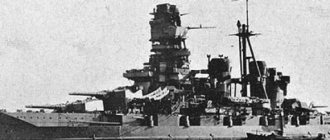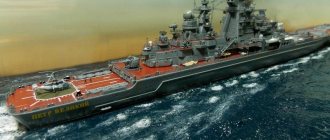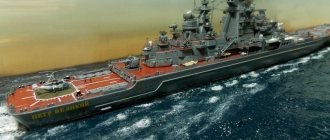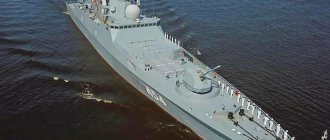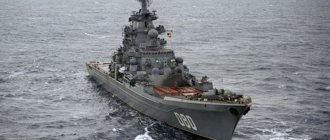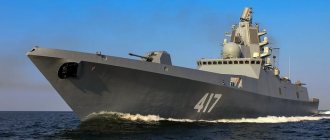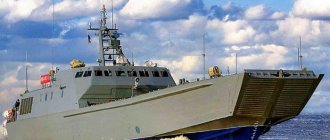Tactical and technical characteristics of the battleship Peresvet
– Manufacturer: Baltic Shipyard – Construction began: November 9, 1895 (Old Style) – Launched: May 7, 1898 (Old Style) – Put into operation: August 6, 1901 (Old Style) .) – Withdrawn from the fleet: 12/22/1916 (old style) – Status: Exploded by mines and sank
Displacement of the battleship Peresvet
– Design normal: 12,674 tons. – Actual: normal 13,810 tons, full 14,790 tons.
Dimensions of the battleship Peresvet
– Length: 132.4 m – Beam: 21.8 m – Draft: 8.43 m
Reservation of the battleship Peresvet
– Main belt 229-178 mm, upper belt 102 mm, deck up to 82.6 mm, towers 229 mm, barbettes 203 mm, casemates 127 or 127/51 mm, deckhouses 152 and 102 mm
Engines of the battleship Peresvet
– 3 vertical triple expansion steam engines, 30 Belleville boilers – Power: 13,775 l. With.
– Propulsion: 3 – Speed: 18.64 knots – Cruising range: 6200 nautical miles – Crew: 769 officers and sailors
Armament of the battleship Peresvet
– 4 × 254 mm/45, – 11 × 152 mm/45, – 20 × 75 mm/50, – 20 × 47 mm/43, – 6 × 37 mm guns, – 2 x 63 mm landing guns – Mine and torpedo armament: Five 381 mm torpedo tubes, 50 min
Design[ | ]
The battleship that became Peresvet was formed under the influence of cruising doctrine with an eye to the construction in England of the lightweight battleships Barfleur, Centurion and Renown. The main difference between the latter was the reduced thickness of the armor and the caliber of the main artillery reduced to 10″. Built in 1893, 1894 and 1896, these ships ranged in displacement from 10,500 to 12,350 dl. t (“Rinaun”) and, like cruisers, had wooden and copper plating on top of steel in the underwater part. In Russia, it was “Rinaun” that was recognized as the most promising prototype. The initial project of a 10,500-ton battleship similar to the Centurion battleship was discussed at an extended meeting of admirals and commanders. In 1895, the developed project was compared with the English "Rinaun", its Russian adaptation, "Petropavlovsk" and the French battleship "Charlemagne" and it was decided to cost the battleship similar to the "Rinaun" type.
Overall assessment of the project[ | ]
“Peresvets” were created as “megacruisers”, intended for raiding in the ocean on the communications of a potential enemy (which at the time of their creation meant Great Britain), superior in combat power to any enemy cruiser and capable of evading any more powerful ship due to superior speed . Both firepower and protection were sacrificed for cruising qualities - seaworthiness and cruising range, as well as speed. In order to reduce coal consumption during economic propulsion, not the usual two-shaft, but a three-shaft power plant was used (they did the same on another ocean raider - the armored cruiser "Russia"). Reality, however, upset all the admirals’ calculations: all three “overexposures” had to act as ordinary battleships. But what’s even worse is that the operating experience of these ships gives very good reason to doubt the possibility of their successful use for their intended purpose.
The most significant design flaw of the Peresvet-class ships was their weak armor. Although the main belt of Harvey steel, traverses and armored deck provided fairly reliable protection for the engine-boiler rooms and ammunition magazines from damage by enemy shells, the unprotected ends could easily be destroyed by medium-caliber high-explosive shells from the numerous 120-152-mm rapid-fire guns armed with battleships and cruisers of that time, not to mention larger caliber landmines. The entry of a large amount of water through the resulting holes led to an increase in draft, loss of speed and deterioration of stability. The situation was aggravated by the fact that when the main belt was immersed in water, the short upper belt could not ensure the ship's unsinkability. This was, apparently, the reason for the quick death of the battleship Oslyabya in the Battle of Tsushima, but the Peresvet was not sunk in the battle in the Yellow Sea only because it was not subjected to such concentrated execution as the Oslyabya, and besides had less overload. A sharp contrast in comparison with them is the behavior of the battleships Tsesarevich and Prince Suvorov, which were subjected to no less intense shelling, but remained afloat (Prince Suvorov was eventually sunk, but by torpedoes, not by artillery fire).
| "Alabama"[2] | "Canopus" | "Kaiser Friedrich III"[3] | "Fuji"[4] | "Shikishima"[4] | "Peresvet" | "Petropavlovsk" | "Rinaun" | "Charlemagne"[5] | |
| Year of laying | 1896 | 1897 | 1895 | 1894 | 1897 | 1895 | 1892 | 1893 | 1894 |
| Year of commissioning | 1900 | 1899 | 1898 | 1897 | 1900 | 1901 | 1899 | 1897 | 1899 |
| Displacement is normal, t | 11 750 | 13 360 | 11 785 | 12 320 | 14 300 | 12 674 | 11 354 | 12 865 | 11 100 |
| Full, t | 12 446 | 14 529 | 11 895 | 12 649 | 15 453 | 14 790 | 11 958 | 14 300 | |
| PM power, l. With. | 10 000 | 13 500 | 13 000 | 14 000 | 14 500 | 14 500 | 10 600 | 12 000 | 15 000 |
| Maximum speed, project node | 16 | 18 | 17,5 | 18 | 18 | 18 | 17 | 18 | 18 |
| Range, miles (on the move, knots) | (10) | 5320 (10) | 3420 (10) | 4000 (10) | 4000 (10) | 5610 (10) | 3750 (10 | 6400 (10) | 3650(10) |
| Reservation, mm | |||||||||
| Type | HS | KS | KS | HS | HS | HS | HS | HS | HS |
| Belt | 419 | 152 | 300 | 457 | 229 | 229 | 406 | 203 | 370 |
| Deck(slopes) | 102 | 51(51) | 65 | 64 | 63(102) | 38(38) | 51-63 | 63(76) | 55 |
| Towers | 356 | 203 | 250 | 152 | 254 | 229 | 254 | 152 | 320 |
| Barbets | 318 | 305 | 250 | 457 | 305 | — | 254 | 254 | 270 |
| Chopping | 254 | 305 | 250 | 356 | 356 | 152 | 229 | 229 | 326 |
| Armament | 2×2×330/35 16×1×152 mm/40 16×1×57 mm 4 TA | 2×2×305/35 12×1×152 mm/45 10×1×76.2 mm/40 4 TA | 2×2×240 mm/40 18×1×150 mm/40 12×1×88 mm/30 6 TA | 2×2×305 mm/35 10×1×152 mm/40 20×1×47 mm/43 5 TA | 2×2×305 mm/40 14×1×152 mm/40 20×1×76 mm/40 4 TA | 2×2×254 mm/45 11×152 mm/45 20×1×76 mm/45 20×1×47 mm/43 5 TA | 2×2×305 mm/40 12×152 mm/45 20×1×47 mm/43 6 TA | 2×2×254 mm/32 10×152 mm/40 12×76 mm/40 12×1×47 mm/43 5 TA | 2×2×305 mm/40 10×1×138 mm/45 8×1×100 mm/45 20×1×47 mm/43 4 TA |
A meeting with enemy cruisers and even a single cruiser would also be dangerous for overexposure. True, the probability of death in such a battle is small, but the resulting holes in the unarmored ends will have an extremely negative impact on the speed and seaworthiness of the ship, and it will be extremely difficult to eliminate them on your own in the open sea and even in a bay on some island, and most likely completely impossible. Thus, even having successfully fought off the enemy, the Russian “megacruiser” will be forced to interrupt the raiding and return home, which in itself is a difficult task due to Russia’s lack of overseas bases and the unconditional supremacy of the enemy (the British) at sea.
The 18-knot speed, two knots higher than that of the predecessors of the “Peresvets” - the Poltava-class battleships - by the time they entered service was no longer uncommon among full-fledged battleships and turned out to be significantly lower than that of modern British cruisers. Thus, the “peresvets” could not effectively fight enemy cruisers, since they were unable to catch up with them, and did not have the ability to easily break away from enemy battleships, without having any significant superiority in speed - all this limited their value as raiders.
Due to the high consumption of coal at the parking lot in Port Arthur, the Peresvets were nicknamed “coal eaters.” When parked, they consumed up to 26 tons of coal per day, at 12 knots - 100 tons (for comparison: the much more powerful and almost the same high-speed battleship "Tsesarevich" consumed 8 tons of coal when parked, and at 12 knots - 76 tons of coal ). Nevertheless, the range was 5610 nautical miles (instead of 6860 according to the project), which is almost one and a half times more than that of Japanese battleships.
The armament of the “peresvets” was, in general, quite sufficient to carry out the tasks that were originally assigned to them.
The complete mechanization of the towers theoretically made it possible for “even a baby” to fire from them, as a contemporary wrote. However, the electrical mechanisms of that time were too unreliable, which was aggravated by the high complexity of installation. As a result, breakdowns were common.
The running 152-mm “peresvet” gun turned out to be absolutely useless. Of the ten remaining guns, four were located close to the water and their use in rough seas was also difficult, especially for the bow pair of guns. However, all ships of that time with casemate artillery had similar shortcomings. A more significant drawback was the weakness of the lifting mechanisms of the Kane casemate guns, which is inherent in all Russian ships.
The low efficiency of the Russian 75-mm Kane guns was explained not by their design flaws, but by the lack of high-explosive shells in their ammunition. Japanese (English-made) guns of similar caliber were slightly better. But almost three dozen small-caliber Hotchkiss guns were by that time clearly superfluous: they were of almost no use in repelling attacks from destroyers.
The undoubted advantage of the Peresvet-class ships is their good seaworthiness and high freeboard, which allows them to maintain significant speed and use artillery even in heavy seas. The ships had very high autonomy. But the copper plating on the first two ships of the series played a more negative than positive role. Of course, their underwater part was much less fouled, but the slightest damage caused electrochemical corrosion of the steel main hull plating and therefore required immediate repairs. In addition, the copper sheathing and its wooden lining had considerable mass. On the last ship of the series, Pobeda, this anachronism from the times of the sailing fleet was finally abandoned.
Finally, one cannot fail to mention the large overload of all three ships in the series. Most sources indicate that Peresvet had a structural overload of 1136 tons, Oslyabya - 1734 tons, Pobeda - 646 tons. Overload not only worsened the speed qualities of the ships (high speeds in tests were obtained in the absence of many reserves and in were absolutely unattainable in real operation), but also caused a significant immersion of the main armor belt in the water, which reduced the already insufficiently high survivability of the ships. Thus, the actual draft of the Peresvet with a normal supply of coal was 8.43 m instead of 7.93 m according to the design, as a result of which the main armored belt rose above the water by only 40 cm instead of 91 cm. With a full supply of coal, the draft reached 9.1 m, and the main armored belt went under water by 30 cm.
Single ocean raiders were poorly suited for squadron combat. It was a mistaken opinion in the Naval Ministry that these ships were not cruisers, but almost full-fledged squadron battleships. However, based on the fate of the Peresvet-class ships and the negative experience of their use in the Russo-Japanese War, it would be wrong to consider the ideas included in the project to be incorrect.
Design Description[ | ]
Case[ | ]
The longitudinal hull set included a vertical keel 89 m long made of 12.7 mm thick sheets, a horizontal keel riveted from two 15.9 mm sheets and five stringers on each side.
The basis of the transverse set was 116 frames. Between the 18th and 96th frames there was a double bottom with a height of 0.99 m; along this entire length, the spacing was equal to 1.22 m. At the bow and stern, before the 18th and after the 96th frames, there was no double bottom, and the spacing was 0.9 m. The beams were channels with a height of 203 to 254 mm ; near the towers they were reinforced with additional longitudinal ribs.
The outer skin belt closest to the horizontal keel had a thickness of 22.2 mm, and the thickness of the other nine belts decreased from 19.1 to 12.7 mm as they moved away from the keel. The outer skin sheets were laid edge to edge, had a length of at least 6 m and a width in the middle part of the hull of 1.22-1.6 m.
Watertight bulkheads divided the hull into ten compartments: ram, bow ammunition magazines, turret bow, three boiler rooms, two engine rooms, turret stern and tiller. The side coal pits had a longitudinal bulkhead and, together with the coal in them, provided additional protection. In the front engine room there was also a longitudinal bulkhead along the center plane.
In the above-water part, the hull was divided into two inter-deck spaces by three decks: the lower (armor), living (battery) and upper, above which a fourth deck ran along two-thirds of the length of the hull - a hinged one, which was a continuation of the forecastle. The entire height from the armored deck to the second bottom housed engine and boiler rooms, ammunition cellars, provision storerooms, underwater mine apparatus rooms, and a steering gear.
The upper deck had a deck made of teak planks (pine was used on the lead ship).
Booking[ | ]
Main armor belt
along the waterline it consisted of slabs of Harvey steel (Krupp steel on Pobeda) with a height of 2.35 m, with a normal draft going 1.44 m under water. The slabs that protected the engine and boiler rooms had a thickness of 229 mm, gradually thinning under water to 127 mm.
In the area of the towers there were thinner slabs, which had a thickness of 178 mm in the above-water part, which decreased to 102 mm under water. The main belt was closed at the 18th and 96th frames with armored traverses
made of 178-mm plates; its length was about 95 m.
An upper belt was located above the main belt
, consisting of 102-mm plates, closed with broken-shaped traverses on frames 35-37 and 77-82. It was significantly shorter than the main belt (about 49 m) and protected the space approximately from the first chimney to the aft casemates of the 152 mm guns, inclusive. The bases of chimneys and the cylinders of the ship's main engines fell into this zone.
Horizontal protection was represented by a carapace armored deck
, which extended along the entire length of the ship and had bevels towards the sides and ends. Throughout the armored citadel, its edges abutted the lower edges of the main belt, and the thickness was 38.1 mm of armor plus 12.7 mm of steel decking, for a total of 50.8 mm. Outside the citadel, the thickness of the armor ranged from 38.1 to 57.2 mm, and the thickness of the decking was 25.4 mm, which in total gave protection from 63.5 to 82.6 mm thick (the bevels of the armored deck were thicker). The armored deck was made of new “extra-soft nickel steel” (on the lead ship of the series, Peresvet, due to technological difficulties that arose at the beginning of the production of a new type of armor, ordinary shipbuilding steel was used).
The residential (battery) deck, which was the roof of the upper citadel, also played a certain role in the horizontal defense. Its thickness within the citadel was mainly 63.5 mm, decreasing to 50.8 mm in the casemates of 152 mm guns.
Main caliber towers
were protected by 229 mm armor, and their barbettes - 203 mm, and the latter was ordered in Germany (probably it belonged to the early samples of steel hardened by the Krupp method, at whose factory it was manufactured). The roofs of the towers had a thickness of 50.8 mm.
Regarding the protection of casemates
For 152 mm guns, data varies. According to some sources, it turns out that the side armor of all casemates was 127 mm, according to others - 51 mm, except for the casemates of two medium guns (one on each side), protected by 127 mm plates. The casemates were protected from longitudinal fire by fore and aft traverses, which covered two inter-deck spaces - from the hinged to the battery deck. The thickness of the bow beam was 127 mm, the stern beam - 102 mm. The internal bulkheads of the casemates had a thickness of 38.1 and 19 mm. The hanging deck, which served as a roof for the upper casemates, had a thickness of 20.3 mm above them. The casemate guns themselves had shields 63.5 mm thick.
Bow conning tower
was protected by 152 mm armor, the rear - 102 mm. Their roofs were probably 50.8 mm thick.
In the space between the battery and upper decks, the chimneys were protected by 51 mm or 38 mm armor (data vary), but this protection was not extended to the hanging deck. Similar armor was used to cover the ammunition elevators that ran above the armored belt.
Artillery weapons[ | ]
The Japanese study the bow turret of the Pobeda, January 1905
Main caliber
included four 254-mm guns with a barrel length of 45 calibers, installed in two turrets produced by the Putilov plant (the guns themselves were manufactured by the Obukhov plant). The towers and tower mechanisms were driven by electricity, which was an innovation in Russia: before that, heavy main caliber installations were equipped with hydraulic drives. The gun locks could open automatically, using the recoil energy after a shot. The horizontal guidance sector of each turret was 270°, the vertical guidance angles of the guns ranged from −5° to +35°. Due to the desire to make the guns as light as possible, the strength of the barrels turned out to be insufficient. In this regard, it was necessary to reduce the charge and strengthen the design, as well as limit the maximum elevation angle to 20°, despite this, the maximum firing range of Pobeda was 88 kbt, Peresvet - 95, Oslyabi - 115, which was more than 82 kbt. Japanese battleships "Shikishima", "Hatsuse", "Asahi" and "Mikasa".
Medium caliber
included eleven 152-mm guns of the Kane system with a barrel length of 45 calibers. Eight of them were located in four two-tier casemates in the corners of the upper citadel (the guns stood on the battery and upper decks; the roof of the casemates was the hanging deck), two more - in two central casemates on the upper deck (one on each side), and the last one - in the bow section below the forecastle deck, but was protected only by a shield.
Each gun had 180 shots: 47 armor-piercing, high-explosive, cast iron, 31 segment and 8 buckshot (according to other sources, 220 shots per barrel).
Anti-mine caliber
was represented by twenty 75-mm Kane cannons with a barrel length of 45 calibers. Eight of these guns stood in the middle part of the ship on the battery and upper decks between the casemates of 152-mm guns (four guns per side on each deck). The remaining four stood on the hanging deck under the bow and stern bridges (two guns per side).
The ammunition of the 75-mm guns included 125 armor-piercing and 175 cast-iron unitary cartridges per barrel.
For arming the landing force
there were two 63.5 mm Baranovsky cannons, as well as seven machine guns.
Mine weapons[ | ]
The ships had three surface and two underwater mine vehicles.
50 spheroconic barrage mines were stored in the mine hold on frames 13-19.
